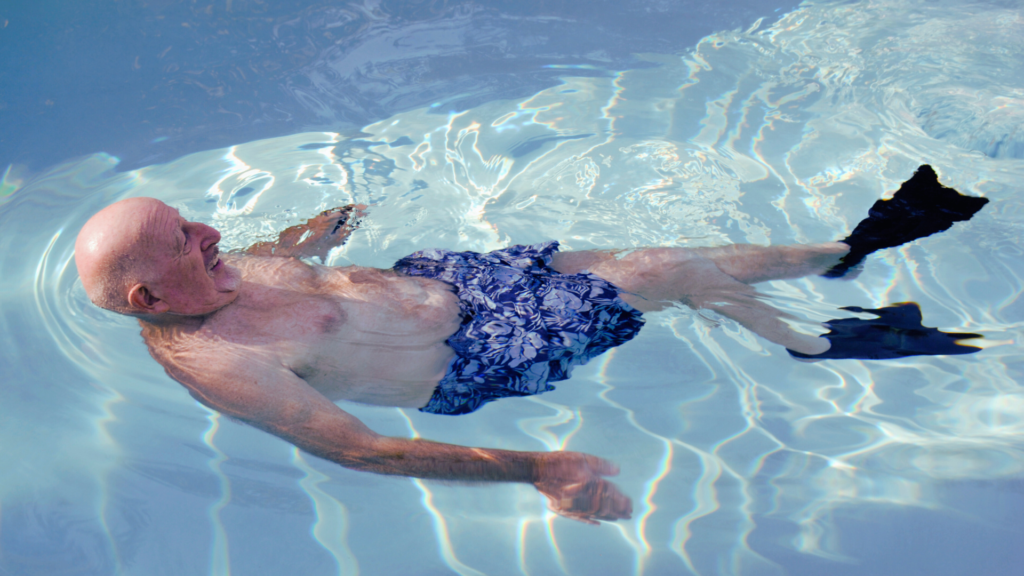If you’ve ever experienced a sharp, stabbing pain in the bottom of your foot near the heel, you may be familiar with a condition known as plantar fasciitis. It’s one of the most common causes of heel pain, and it can significantly impact your daily activities, especially those requiring long-standing or weight-bearing periods.
As a longtime swimmer and coach, I’ve seen many athletes and fitness enthusiasts, including myself, struggle with this foot condition. The pain usually intensifies with the first steps in the morning or after long rest periods, making it a challenging condition to live with.
Many people with plantar fasciitis are advised to avoid high-impact exercises that aggravate pain. This is where swimming comes in. It’s an exercise that is easy on the feet, making it an excellent option for those suffering from plantar fasciitis.

So What is Plantar Fasciitis?
Plantar fasciitis is a common foot disorder that results in pain in the heel and the bottom of the foot. The discomfort is typically most severe during the first steps after waking or following a period of rest. The condition is caused by inflammation of the plantar fascia, a thick band of tissue that connects your heel bone to your toes, providing support to the arch of your foot.
Excessive tension or stress on the plantar fascia can lead to small tears, causing irritation or inflammation, known as plantar fasciitis. Risk factors include obesity, high-impact activities like long-distance running, jobs that involve prolonged standing, and improper footwear. It’s particularly common in runners, overweight individuals, and those wearing shoes with inadequate support. If you’re experiencing heel pain, it’s crucial to consult with a healthcare professional or podiatrist for a proper diagnosis and treatment plan.
This link provides comprehensive information about plantar fasciitis, its symptoms, causes, and treatment options.
Is Swimming Good for Plantar Fasciitis? The Benefits
Swimming is a great exercise for those with plantar fasciitis pain for several reasons:
- Low-Impact Nature: Unlike running or jumping, swimming is a low-impact exercise. It doesn’t place excessive force on the foot, reducing the risk of aggravating the plantar fascia, the band of tissue that connects the heel bone to the toes.
- Buoyancy of Water: The buoyancy in water reduces weight on your feet, relieving a lot of stress on the plantar fascia. This can help reduce pain and inflammation, common symptoms of plantar fasciitis.
- Achilles Tendon Stretching and Strengthening: Swimming helps stretch and strengthen the Achilles tendon, which is connected to the plantar fascia. This can help relieve pain and prevent further injury.
- Inflammation Reduction: Swimming can help reduce inflammation of the plantar fascia. The cool water can soothe the inflamed tissue, relieving pain and stiffness.
Swimming Exercises for Plantar Fasciitis
Now, let’s talk about some specific swimming exercises for plantar fascia that can help improve your condition:
This pool-based exercise is designed to stretch your legs and feet without adding extra weight, relieving plantar fasciitis symptoms.
- Stand with both hands on the pool’s edge and your feet gently resting on the floor.
- Bring your legs up and press both feet against the wall. Start with your knees bent, take a deep breath, and exhale as you extend your legs out and away from the wall.
- Feel a stretch in your legs and feet, hold this position for a few seconds.
- Repeat this stretch 10 times.
- This exercise helps stretch your legs and feet without putting additional weight on them.
- Regular practice of this exercise can help alleviate the pain and stiffness associated with plantar fasciitis, contributing to overall foot health.
Fin Sprints
This high-intensity exercise is designed to strengthen your lower body and arms, improving cardiovascular health and breathing technique, all while using fins to boost speed without adding strain to your feet.
- Put on your fins and enter the pool.
- Choose a stroke such as freestyle or backstroke and sprint for 25 yards without stopping.
- Take a minute to rest before repeating the drill.
- This exercise strengthens your lower body and arms, and improves cardiovascular health and breathing technique.
- Regular practice of this exercise can enhance your overall swimming performance and contribute to managing plantar fasciitis symptoms by strengthening the lower body without straining the feet.
This swimming exercise targets your legs, abs, and glutes, offering a robust workout without adding strain to your feet.
- Align yourself at the pool wall’s edge, placing your left hand on the edge and your right hand flat against the wall, palm down.
- Extend both legs and flutter kick, using your hips and abdominal muscles to increase speed.
- Execute this exercise as fast as you can for 30 seconds.
- Repeat the exercise until you feel fatigued.
- This exercise strengthens your legs, abs, and glutes without straining your feet.
- Regular practice can contribute to overall muscle strength and endurance, aiding in managing plantar fasciitis symptoms.
This exercise, performed with a kickboard in the shallow end of the pool, is designed to improve your flutter kick and strengthen your foot and leg muscles.
- Stand in the shallow end of the pool with a kickboard.
- Extend your arms and balance on the kickboard, then alternate your legs in a rapid flutter kick motion.
- Perform the flutter kick as fast as you can, covering a distance of 50 meters.
- Take a 10-second break.
- Repeat this exercise 10 times.
- This exercise improves your flutter kick and strengthens your foot and leg muscles.
- Regular practice of this exercise can enhance your swimming technique and contribute to the management of plantar fasciitis symptoms by strengthening the lower body.
This simple yet effective pool exercise offers numerous benefits by strengthening the lower leg and foot muscles.
- Start in the shallow end of the pool where you can comfortably stand.
- Stand upright and slowly lift one leg to the side.
- Gently lower the leg back down and repeat the movement with the other leg.
- This exercise strengthens your lower leg and foot muscles.
- Regular practice can help stabilize the foot and reduce plantar fasciitis pain.
This exercise improves your flutter kick while strengthening your foot and leg muscles.
- Sit on the edge of the pool with your legs extended in front of you in the water.
- Flex and point your toes in a controlled manner.
- Repeat this movement multiple times, ensuring a good stretch with each flex.
- This exercise stretches the plantar fascia and calf muscles.
- Regular practice can help alleviate the pain and stiffness associated with plantar fasciitis.
Remember, it’s important that the exercises you perform don’t cause pain. If you experience pain during these exercises, stop and rest your feet. You might also want to schedule an appointment with a podiatrist to learn more about your treatment options.
Proper Technique and Precautions

When swimming with plantar fasciitis, it’s crucial to maintain proper form and technique. This is about maximizing the benefits of your workout and preventing further strain or discomfort. Here are some tips for swimming with caution:
- Listen to Your Body: This is perhaps the most important advice I can give. If you feel pain in your feet or legs while swimming, it’s a sign that you need to slow down or modify your technique. Overexertion in the water can aggravate your condition, so staying within your comfort zone is essential.
- Warm Up and Cool Down: Just like any other exercise, it’s important to warm up before you start swimming and cool down afterward. This can include gentle stretches and exercises designed to strengthen your leg muscles and increase flexibility.
- Use Swim Aids: If you’re new to swimming or if you find certain strokes painful, consider using swim aids like kickboards or pull buoys. These can help you maintain good form and focus on specific parts of your body without putting too much stress on your feet.
Consult a professional if you’re unsure about your technique or if swimming causes pain; schedule an appointment with a healthcare professional or a qualified swimming coach. They can provide personalized guidance and help you swim in a way that’s beneficial for your condition.
Comparison with Other Exercises
When it comes to managing plantar fasciitis, not all exercises are created equal. High-impact activities such as running or jumping can put a lot of stress on your feet and make your calf muscles tighter, which can aggravate your condition. On the other hand, swimming is a low-impact exercise that is easy on the feet and can help reduce pain and inflammation.
Here’s a comparison of swimming with other common exercises:
| Exercise | Impact Level | Benefits for Plantar Fasciitis |
|---|---|---|
| Swimming | Low | Reduces strain on feet, helps stretch and strengthen foot and leg muscles, reduces inflammation |
| Running | High | Can aggravate plantar fasciitis due to high impact on feet |
| Jumping | High | Can cause pain and make plantar fasciitis worse due to high impact on feet |
| Walking | Low | Can help stretch the plantar fascia and Achilles tendon, but prolonged walking can cause discomfort. |
| Cycling | Low | Non-weight-bearing exercise that can complement swimming but doesn’t provide the same level of foot and ankle flexibility |
While swimming is a great exercise for plantar fasciitis, it’s also beneficial to incorporate other low-impact exercises into your routine. Activities such as cycling or yoga can complement your swimming workouts and contribute to overall foot health. However, listening to your body and avoiding any exercises that cause pain is important.
Remember, plantar fasciitis is a condition that requires patience and care. With the right approach to exercise, including a good swim routine, you can manage your symptoms and get back to enjoying your active lifestyle.
Other Foot Conditions Swimming Can Help With
Swimming is widely recognized as a low-impact activity suitable for individuals of all ages, sizes, and fitness levels. While it is commonly known for its numerous health benefits, swimming goes beyond being just a fantastic workout option and can contribute to improving various foot conditions. Several studies have demonstrated the positive impact of swimming on foot health. Let’s take a look at some other foot conditions swimming can help with:
- Achilles Tendonitis: Achilles tendonitis occurs due to the overuse of the Achilles tendon, which connects the calf muscle to the heel bone. Symptoms include pain, stiffness, and swelling in the affected area. Swimming helps by stretching and strengthening the Achilles tendon while also reducing inflammation.
- Bunions: Bunions are joint deformities at the base of the big toe. They can result from factors such as genetics, arthritis, or ill-fitting shoes. Symptoms include pain, swelling, and redness around the big toe joint. Swimming can help alleviate pain and reduce inflammation associated with bunions.
- Metatarsalgia: Metatarsalgia causes pain in the balls of the feet and often arises from wearing improperly fitting shoes or engaging in activities that exert repetitive stress on the feet, like running. Swimming can help mitigate pain and inflammation for individuals with metatarsalgia.
- Posterior Tibial Tendon Dysfunction: Posterior tibial tendon dysfunction results in pain and swelling in the ankle and foot due to overuse or repetitive stress. Swimming can be beneficial by stretching and strengthening the affected muscles and connective tissues, potentially reducing pain and inflammation.
- Rheumatoid Arthritis: Rheumatoid arthritis is a chronic inflammatory disorder affecting the joints. The condition causes pain, stiffness, and swelling. Swimming can help alleviate pain and reduce inflammation for individuals with rheumatoid arthritis.
- Shin Splints: Shin splints cause pain in the lower legs due to overuse or repetitive stress on the feet or legs. Swimming can aid in stretching and strengthening the muscles and connective tissues in the legs, potentially reducing pain and inflammation.
- Stress Fractures: Stress fractures are small cracks in the bones resulting from repetitive stress or overuse. They can cause pain and swelling in the affected area. Swimming can help individuals with stress fractures by reducing pain and inflammation.
- Tarsal Tunnel Syndrome: Tarsal tunnel syndrome leads to foot pain, numbness, and tingling due to nerve compression. Swimming can assist in reducing pain and inflammation associated with this condition.
- Tendonitis: Tendonitis involves inflammation of the tendons and often arises from overuse or repetitive stress on the affected tendon. Swimming can help reduce pain and inflammation in individuals with tendonitis.
If you’re interested in how swimming can also benefit other conditions, check out our articles on the benefits of swimming for managing sciatica or our article on the benefits of swimming while pregnant.
FAQs
Conclusion
In conclusion, swimming is a fantastic, low-impact exercise that can significantly help manage and alleviate the pain caused by plantar fasciitis. It allows you to stay active and fit without putting undue stress on your feet, making it an excellent choice for those struggling with this foot condition.
However, it’s important to remember that while swimming may provide relief, it’s not a standalone cure for plantar fasciitis. It should be part of a comprehensive treatment plan that may include rest, stretching, and possibly medical interventions.
As always, it’s crucial to consult with a healthcare professional or a podiatrist for personalized advice and guidance. They can help you understand your condition better and provide recommendations tailored to your specific needs.
So, if you’re battling plantar fasciitis, why not dive in and give swimming a try? It might just be the relief your feet have been longing for!






